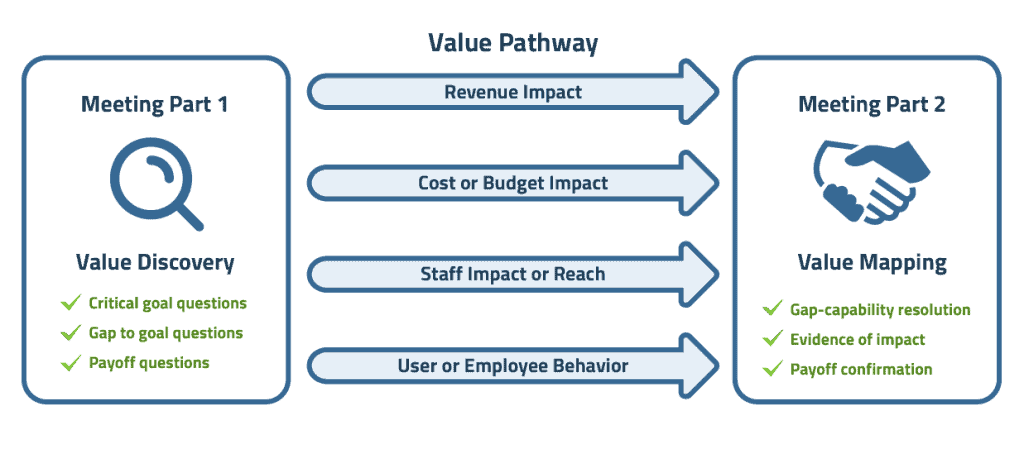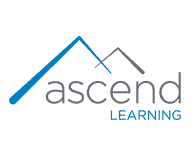Sellers do not close deals, buyers close deals. The role of the seller is to guide the buyer to a close with the right questions – questions that surface a prospects’ pain and turn them into potential value. This sales truth was impeccably documented1 by Neil Rackham, the author of the 1988 classic, SPIN Selling.
Rackham’s insight is more true today than it was in the 1980s. Today’s buyers come to meetings deeply informed with a stronger sense of their goals and a lot less time for sellers. Today’s buyers are less patient with a careful walkthrough on their situation, problems, and implications of those problems and instead want to quickly understand a potential vendor’s value to them.

In this environment, we can build deal momentum by quickly getting to buyer critical goals with a known performance gap, targeted improvement and potential payoff. We call this process value discovery.
Value Pathways Framework
A helpful way to apply this thinking in a systematic way is to use a value pathways framework to focus sellers on value discovery and value mapping as distinct steps in buyer engagement.
Too often sellers talk about their product before understanding what a buyer really values. As a result, many sales meetings leave buyers bored by product pitching and demos rather than energized by effective value mapping between our capabilities and their desired payoffs. Committing to value discovery helps us guide a buyer to one or more value pathways that our product or service can unlock.
The rest of this post focuses on the left side of the value pathways framework, value discovery. For a deeper look at the process of value mapping, and specifically how we can use value discovery to then map to key product capabilities, targeted improvements and desired buyer payoffs, check out the next post in our Insight series, here.
Value Discovery: Start with Identifying a Critical Goal
Good value discovery means spending the first 5-10 minutes of every buyer conversation on discovery or rediscovery of a buyer’s critical business goals and gaps to achieving those goals. Every prospect has a number of competing priorities and goals for their work, but critical goals rise above the rest.
Critical goals typically align to an organizational-level priority, like improving revenue, reducing costs, managing budgets, increasing staff impact or changing user or employee behavior. Critical goals can also be identified by a known gap between a current state and an ideal state or a known target improvement. It is resolution of this gap to achieve a targeted improvement on a goal that creates a payoff to motivate a purchase.
The most basic line of value discovery questions to surface a critical goal focus on either goals or gaps. For example:
- Goal Questions:
- “Which of your goals and priorities have the most significant organizational impact?”
- “We work with your peers on X, Y, and Z goals, any of these at the top of your list?”
- Gap Questions:
- “What is your current state and ideal state for that goal?”
- “Do you have a target improvement?”
- “Any barriers keeping you from your ideal state or target improvement?”
Use Nested Discovery to Uncover Value Pathways
In good selling we do not move to product discussion, product demos, or a discussion of decision-making until we have a clear idea of the buyer’s critical goal and payoff. In the best sales conversations, we use nested discovery questions that link goal and gap exploration across one or more buyer value pathway. Our goal in three or four questions is to engage a buyer with something they want to solve. If we get a hit with our initial set of questions, it usually earns us the right to ask more questions.
Here are two very different company strategies for nested discovery across several value pathways:
| Company | Establishing a Buyer Critical Goal |
|
Provider of curriculum and assessment solutions for professional education of nurses, pharmacists, EMTs, insurance and others |
Buyer Value Pathways
Nested Goal/Gap Discovery Questions
|
|
Data-driven retail personalization platform for footwear and apparel retailers |
Buyer Value Pathways
Nested Goal/Gap Discovery Questions
|
Build Deal Velocity with a Payoff
A key element of value discovery that builds deal velocity is finding a payoff. Once you have surfaced a known buyer gap or clear targeted improvement, you know better if a buyer has a genuine critical goal. It then becomes important to see if we can work with our buyer to establish a clear payoff to solving the known gap or to achieving the targeted improvement.
A strong payoff statement is probably the single most important strategy a seller has to qualify a deal for a critical goal and build deal velocity. A payoff statement captures a critical business, a known gap or desired improvement on that goal and specific payoff to solving that gap and advancing the goal.
A good payoff statement is our most important “sell through” tool, giving a champion a crisp way to present a case for a conversation and bring in other decision makers. A payoff statement should be recapped at the end of an initial discovery call, reconfirmed in each prospect call and included at the beginning of a follow up email, as a way to keep focus on the goal for a potential partnership.
Depending on your selling style and target buyer there are four different types of payoff questions you can put to a champion to work on co-developing a payoff statement.
- VP or C-Level Priority:
- “What outcome or improvement would make you a hero to your VP or leadership?”
- “Is the critical goal a named 2020 business goal or roadmap issue?”
- Business ROI Case:
- “Could we build an ROI case together?”
- “What is a 1%-2% improvement in the targeted goal we discussed worth in terms of increased revenue or decreased?”
- Peer Payoff:
- “With organizations similar to yours we have typically achieved 3-5% gains in your target improvement area. Would that get your team’s attention?”
- Cost of Doing Nothing:
- “If you do nothing at all about the challenge and pains we’ve discussed, is that a sustainable outcome? If not, what’s potential risk or cost?”
Assessing Your Value Discovery: A Simple Self-Diagnostic
Here are a few questions you can ask yourself as you think about making the transition from product-driven to value-driven buyer discovery and engagement:
- Have you developed discovery questions that link to organizational goals, improving revenue, reducing costs, managing budget, increasing staff reach or increasing organizational insight?
- Are critical goal questions linked so it is easy to probe quickly on two, three, or four value areas?
- Do you have gap questions that highlight the difference between a current and ideal state?
- Do you have payoff questions that draw out a buyer on the ROI case, organizational impact, or costs of doing nothing?
In the best selling, we do not move to product discussion, product demos, or a discussion organizational decision-making until we have a clear idea of buyer critical goal and payoff. If we ask the right questions, prospects will tell us exactly their priorities that are most likely to get organizational support and the payoff that would be needed to get a priority across the finish line.
____________
1Rackham and a team of 40 researchers in the 1980s. They collectively observed 35,000 sales calls done by 10,000 sales people in 23 countries over 12 years.



